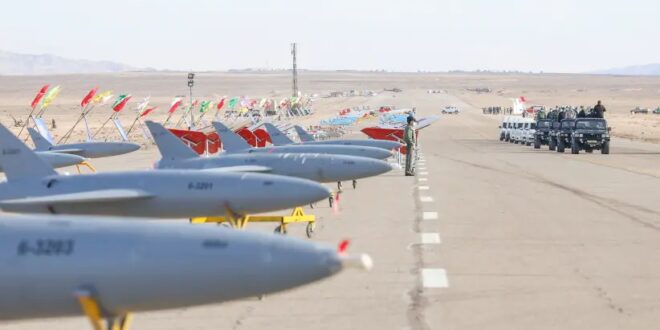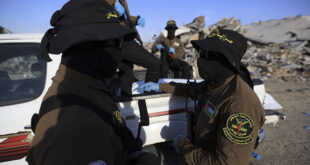Iran’s drone program, unlike its nuclear weapons program, is not secretive. The Islamic Republic openly brags about its drone capabilities.
Iranian drones are an emerging threat to the Middle East. In 2019, Iran used a combination of drones and cruise missiles to attack the giant Abqaiq oil-processing facility in Saudi Arabia, using precision strikes to send a message that Iran’s drones could not strike at will across the region and destabilize economies and countries.
Now Iran’s drones are again in the spotlight, following reports by The Wall Street Journal, Fox News and other media.
Iran’s drones are reshaping the security situation in the region, the Journal reported. It cited the July attack on a tanker in the Gulf of Oman that killed two crew members. Iran has trafficked drone technology to Hamas in Gaza, and in its May war with Israel, Hamas used Iranian-style drones for the first time, the report said.
Fox cited reports by Iranian dissidents that Iran would use drones to destabilize the region.
Iran might target Al-Harir base in northern Iraq’s Kurdistan Region, where US forces are allegedly present, The National Interest magazine reported. The report cited Iranian attacks on dissident groups in the Kurdistan region. Iran has used drones to target US forces in Erbil and also against dissidents.
Iran’s drone program, unlike its nuclear-weapons program, is not secretive. The Islamic Republic openly brags about its drone capabilities. It highlights every new drone and makes outrageous claims about their capabilities. Iran has claimed its drones can fly thousands of kilometers and that it has the ability to arm some of them with missiles.
What we know is that Iranian drones can carry out precision attacks when they are preprogrammed with a set of coordinates. They can wreak havoc, but they are not a weapon that wins wars.
Iran’s drones can attack military parades, airports, oil facilities and tankers. Tehran reportedly used a drone to target a CIA hangar at Erbil’s airport, The Washington Post reported in April. That means Iran’s real asset is its intelligence about where to attack. The drones themselves are interesting because they can be transported or assembled in different places.
FOR INSTANCE, Iran has based drones at T-4 base in Syria and used them to target Israel in February 2018 and this past May. It has provided drone-making technology to the Houthis in Yemen and has downed US drones and copied Israeli drones.
This allows Iran to traffic the technology and have plausible deniability about the use of the drones. This is because they can pretend the drones being used to attack the US in Iraq – or tankers off the coast of Yemen, or to attack Israel from Syria and Iraq – may be drones flown by proxies, such as Hezbollah, Hamas, Houthis or Hashd al-Shaabi.
Although this gives Iran leverage in the region, it doesn’t give it a strategic win; rather, it’s a way to tactically harass its enemies and then hide behind a smoke screen. This is the Iranian way of war these days, and the drones are simply a symptom and a tactic they have adopted, which extends their long arm.
Iran already perfected the use of terrorism, extending its long arm to kill dissidents in Europe and attack US, Israeli, Jewish and other targets around the world. The drones are a new technology Iran is using in a specifically Iranian way: No other country uses drones like this.
Increased attention is now being put on the Iranian drones, indicating that Iran is no longer able to fly under the radar with these systems. The question that should be asked is what comes next for Iran’s plethora of drones?
The drones come in family groups, such as the Ababil, Mohajer and Shahed classes. These range in capabilities from surveillance drones to those that can fly thousands of kilometers. Some of them are kamikaze drones, while others return to base.
Iran has now sent large numbers of drones to its allies in the region, including the Gaza Strip, Iraq, Yemen, Syria and Lebanon. It also seeks to export some abroad, including to Venezuela, for example. It is also now basing them at sea, putting them on its Navy ships and IRGC fast boats.
The drones sometimes behave more like cruise missiles, slamming into a target and self-destructing. That gives them plausible deniability and a kind of ability to strike through air defenses and radar by using potential swarm attacks of large numbers of drones.
Iran has shown proficiency in getting around Saudi and US air defenses in some cases. Israel has used Iron Dome and missiles fired from aircraft and helicopters to shoot down the relatively slow drones.
THE FULL picture of what comes next has not emerged. After the 2019 attack, there were concerns that Iran had stumbled upon a kind of drone “Pearl Harbor” in the region, and many air-defense systems were updated to deal with drone threats. But there are not enough radar and air-defense systems around the region to defend everything.
That is why the US, Saudi Arabia, Israel and others must concentrate on defending key strategic areas. For Israel, a small country, the challenge is not as great. But drones can strike at tankers and also natural-gas sites.
That means they can strike almost anywhere. Iran had moved drones to Yemen that could strike as far as Eilat, Newsweek reported in January.
That threat has not fully emerged, but the recent reports indicate the region is taking the Iran drone threat seriously. Luckily for those who study this, Iran is not trying to hide its drones. It openly parades them by the dozens, and its allies in Iraq also put them on trucks to display in military parades.
Iran’s capabilities are known. The question is whether its adversaries will put in place enough missiles, radar systems and guns to down the drones in the future or predict where Iran’s next target may be.
 Eurasia Press & News
Eurasia Press & News




